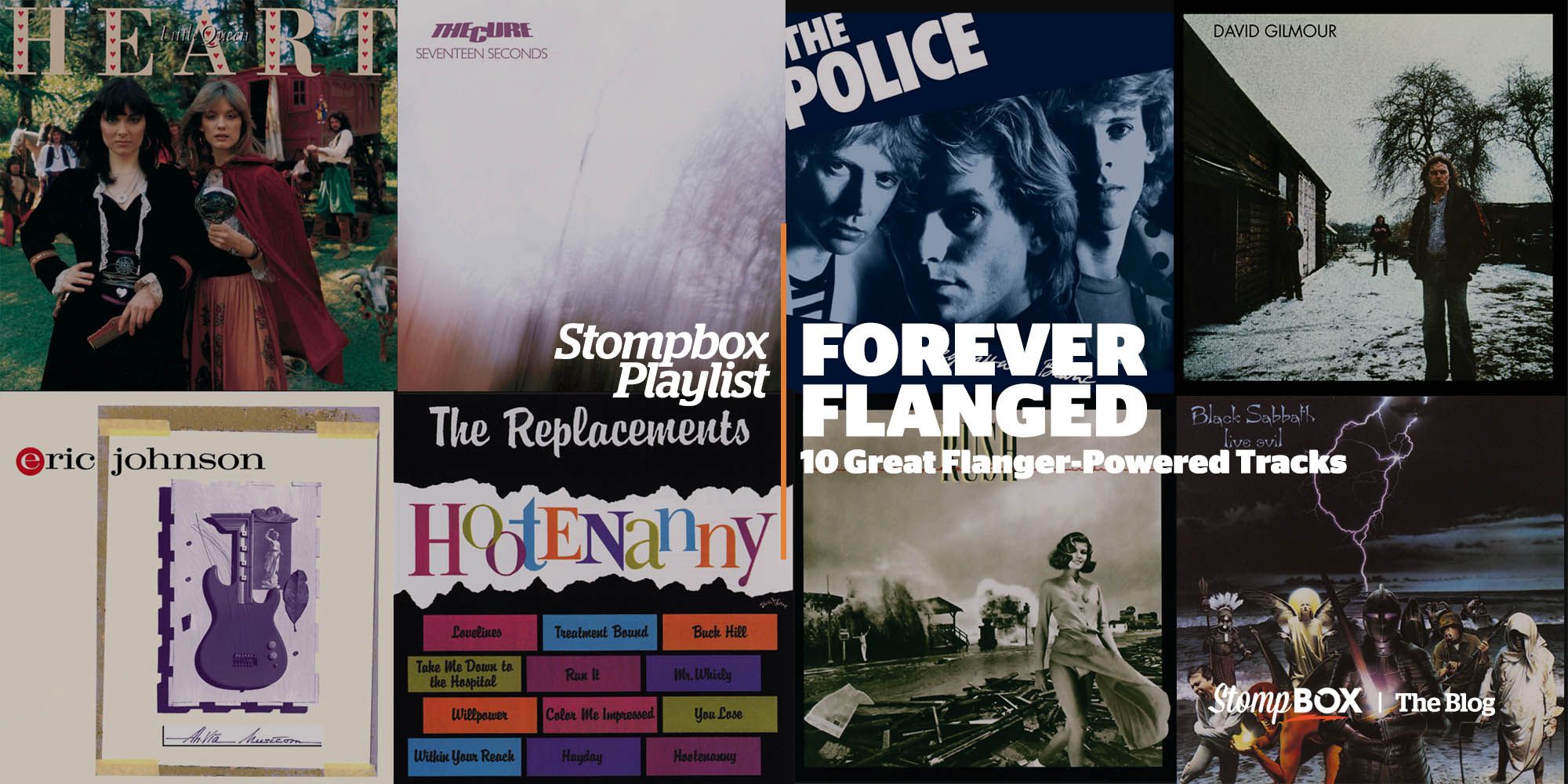Forever Flanged: 10 Great Flanger-Powered Tracks | Stompbox Playlist
Discovered by Les Paul in the late 1940s, flanging — the “swooshing” sound caused by mixing two identical recordings together while one recording is slightly relayed — really came into vogue in the late 1960s, when psychedelically-inclined artists like The Beatles, Jimi Hendrix, The Small Faces, The Nazz and The Status Quo employed it to dose their songs with an extra degree of trippiness. But the effect in those days was purely studio-based; the musicians had to rely on a recording engineer to manually slow one of the tape reels during the mixing process.
It wasn’t until 1976, when Electro-Harmonix introduced the first of many iterations of their Electric Mistress pedal, that guitarists were able to achieve the same effect with a stomp box, and add it to their personal musical arsenal both on stage and in the studio.
Flanger pedals are definitely an acquired taste — some guitarists swear by them, others wouldn’t be caught dead playing through one — but they’ve definitely left their mark on rock n’ roll. Here are ten notable tracks loaded with flanger-y goodness:
Heart — Barracuda
One of the most iconic flanged guitar riffs of all time, the chugging intro of Heart’s 1977 hit — and the laser-beam sounds that punctuate the closing seconds of the song — were achieved via a flanger pedal that lead guitarist Roger Fisher had assembled from a kit sold by a company called Phoenix Systems. Fisher would use the same flanger on “Mistral Wind,” from Heart’s 1978 album Dog & Butterfly.
David Gilmour — Mihalis
An early adopter of the Electric Mistress, Pink Floyd’s lead guitarist loved how the pedal added an extra layer of richness and expressiveness to his already otherworldly playing. For the opening instrumental from his self-titled 1978 solo album, Gilmour applied the effect to both his rhythm guitar tracks and his leads, with absolutely gorgeous results.
Police — Walking on the Moon
While many guitarists are drawn to the flanger’s jet-like swoosh, Andy Summers of the Police eschewed the sweeping powers of his Electric Mistress and used it to instead dial in a subtle chorus-like effect. Combined with his MXR Dyna Comp and Echoplex units, he used the effect to create the uniquely spacey and haunting tones heard throughout 1979’s Regatta de Blanc.
Magazine – Permafrost
One of the most influential (yet still criminally underrated) guitarists of the post-punk era, the late John McGeoch was an avid devotee of the MXR M117R flanger, and wielded it repeatedly in service of Magazine, Visage, Siouxsie and the Banshees and PIL, among others. His arresting and inventive use of the pedal can be heard loud and clear on this standout track from Magazine’s 1979 LP, Secondhand Daylight.
Rush — The Spirit of Radio
Another devoted lover of the Electric Mistress, Alex Lifeson used the effect on numerous Rush tracks, but perhaps never quite so thrillingly as on the swirling arpeggios of 1980’s “The Spirit of Radio,” which crackle with life just like the “invisible airwaves” that Geddy Lee is singing about.
The Cure — A Forest
A veritable flanger orgy, this standout track from The Cure’s 1980 album Seventeen Seconds utilized seven different flanger units to help achieve its gloriously gloomy atmosphere — Mike Hedges, who co-produced the album with band leader Robert Smith, put the effect on the cymbals and bass, as well as Smith’s guitar. For his guitar parts, Smith preferred to use a Boss BF-2, which soon became the de rigeur flanger pedal for 80s goths.
Van Halen — Unchained
The King of the MXR 117 Flanger, Eddie Van Halen employed the pedal as an integral part of his fabled “Brown Sound” from Van Halen’s first album onward. While the main riff of 1981’s “Unchained” is unquestionably fierce in its own right, Eddie used the flanger sweep to give it an extra kick in the ass.
Black Sabbath — E5150
Once guitarists started adding flangers to their pedal boards, it was only a matter of time before bassists followed suit. On this instrumental from 1981’s Mob Rules, Sabbath bass man Geezer Butler combined a Tycobrahe Pedalflanger with a Tycobrahe Parapedal wah to create an ominous soundscape that sounds like a prelude to Godzilla (or something even more terrifying) rising up from the depths of the ocean.
Replacements — Die Within Your Reach
Graduates from the plug-in-and-play school of punk rock, The Replacements were never known to be big gearheads, so the mere presence of a flanger — the exact model used (and probably borrowed) by Paul Westerberg has been lost to history — on this standout track from 1983’s Hootenanny raised a few eyebrows upon its release. Upon further reflection, though, the effect’s desolate swoop only adds to the song’s sense of loneliness and desperation.
Eric Johnson — High Landrons
Like David Gilmour, Eric Johnson has often used a flanger to further enrich his already-gorgeous tones. But rather than go the Electric Mistress route, Johnson utilized a T.C. Electronics Stereo Chorus + Pitch Modulator & Flanger for this stunning track from 1990’s Ah Via Musicom.

1 Comment
Join the discussion and tell us your opinion.
[…] miss Dan Epstein’s amazing Forever Flanged piece in this month’s awesome blog offerings, Eilon Paz’s unique audience with our dear friend […]